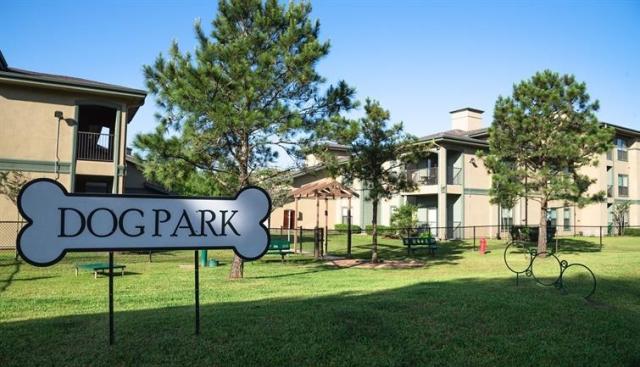If your roommate has four legs and fur, you have more things to consider when searching for an apartment than just the number of bedrooms and square footage. Will your best bud be welcome? How will the extra pet fees impact your monthly expenses? You might want your tail-wagging sidekick to enjoy some amenities like an on-site dog park. There’s much to consider when searching for pet-friendly apartments, so here’s how to find a terrific place for you and your pet.
What makes an apartment pet friendly?
There are varying degrees of pet-friendliness. For example, many apartments allow pets, but with a variety of caveats. You might find an apartment that will only allow cats (a cat-veat?). The rental may restrict pet size to 20 pounds or less. There may be a variety of extra costs associated with having a pet, including monthly pet rent. These restrictions and fees are common in apartments that allow pets.
On the other hand, you might find apartment communities with only a few breed restrictions, no weight limit, an on-site dog park or a pet-washing station, and limited extra fees. These pet-friendly communities welcome pets with open arms — and treats in the office. This is pet-friendliness taken to a whole new level. Some of these communities even offer pet-focused events like pet costume parades and puppy socials.
Consider how pet-friendly you’d like your apartment community to be. What pet amenities are your must-haves? For example, you might be fine with not having an on-site dog park, but pet clean-up stations are a must. Perhaps a community that only allows small pets is ideal for you, or maybe you need a rental that accepts large breeds.
What to Know About Apartment Pet Restrictions
When searching for a new rental, it may feel as though apartment communities are against your German Shepherd, but they’re not. Most banned breeds are the result of city or county ordinances or by the apartment community’s insurance policy. Dog bite claims are all too common for insurance companies, and as a result, the liability coverage is increasingly stricter and more expensive. Here are a few breeds that you might find on a restricted breeds list:
- German Shepherds
- Mastiffs
- Rottweilers
- Akitas
- Cane Corsos
- Doberman Pinschers
- Malamutes
- Staffordshire Terriers
- American Pit Bulls
- Huskies
- Dalmatians
- Chow Chows
- Presa Canarios
- Boxers
- Wolf Hybrids
If you have several pets, you may discover that finding a rental that allows multiple pets is difficult. Many apartment communities limit residents to two pets. Apartments typically have limited space, so this rule is intended to keep residents from having too many animals contained in a small area — a situation that could lead to damage in the apartment. Apartment communities often have weight restrictions for similar reasons. Large dogs, or multiple dogs, might need more space than the typical apartment floor plan offers.
Perhaps your pet isn’t a dog or cat. Maybe your beloved roomie slithers. Maybe you have an iguana or a ferret. You might find it difficult to rent an apartment if you have an exotic pet, as many apartment communities don’t allow them. For clarification, “exotic” could mean any animal that isn’t a dog or a cat, including birds, snakes, fish (fish tanks), turtles, frogs, hamsters, rabbits, ferrets, and chinchillas. Don’t try to sneak in an exotic pet because it’s in a cage or a tank. This would be a violation of your lease agreement and could be considered grounds for eviction.
Service dogs and emotional support animals are exempt from all pet restrictions, even for apartment communities that don’t otherwise allow pets. According to Federal Fair Housing laws, assistance animals are not pets.
What to Consider When Looking at Pet-Friendly Apartments
When searching for pet-friendly apartments, you’ll want to take some things into consideration that you might not otherwise. For example, your dog (especially if you are planning to get a puppy) will need to go out frequently (for a puppy, even in the middle of the night). In this case, a ground floor apartment may be much more convenient than something on the second or third (or 21st) floor.
The apartment layout is also important. You want enough space for you, your pet, and all the accoutrements that come with a pet. You’ll want a space for your pet’s bed or crate, food bowls, and your cat’s litter box.
Consider the materials used in the apartment, as well. For example, laminate, tile, or vinyl floors are better suited for pets than carpet or hardwood. You’ll have to worry about stains on carpets or scratches on hardwood, so if you rent an apartment with this type of flooring, consider using throw rugs in spaces where your dog frequents and waterproof mats under the bowls.
While a balcony is a terrific amenity for you, it could be less so for your pet. Your cat (or dog, although it’s less common) could fall from the balcony or squeeze through the railings and get lost or hurt. Injuries from balcony falls are so common with cats there’s a name for it: high rise syndrome. But it doesn’t have to be a high fall to hurt your pet. According to PetMD, even a fall from a second-floor balcony could cause injury. If you rent an apartment with a balcony, consider keeping your pet off it. If you want your pet next to you as you enjoy your morning coffee al fresco, try to find a screened-in balcony or an apartment with a sunroom instead.
During your pet-friendly apartment search, be sure to consider the neighborhood. Is it a pet-friendly area? Will you have easy access to sidewalks for dog walks? Are there nearby parks with off-leash areas? Where is the nearest vet’s office or animal hospital? If you’ll be taking your dog to doggie daycare, is your preferred location on your way to work?
Will I pay more for a pet-friendly apartment?
It’s likely that you’ll encounter a variety of additional costs when renting with a pet. As you search, you might encounter a variety of pet fees, pet rent, and pet deposits. Only one of these, the pet deposit, is refundable. If your pet damages the apartment (scratches on the wood, stains on the carpet, etc.), the cost to repair those damages will be taken from the pet deposit.
A pet fee is a one-time, nonrefundable fee. If an apartment community requires pet rent, you’ll pay that every month along with your regular rent (so yes, in this case, you will pay more each month for your pet-friendly apartment).
Pet deposits can’t be charged in some states, so if you are curious about your local laws around pet fees, be sure to do some research.
In addition to the fees you’ll pay the apartment community, be sure to factor in vet bills, pet food, pet daycare, and grooming costs. Having a pet can add up quickly, so do your research before getting a pet.
What to Do If You Have a Large or Restricted Dog Breed
If you have a large or restricted dog breed, more than two pets, or an exotic pet, finding a rental will be more challenging, but it can be done.
Look for rentals with independent landlords, especially if you have a large, active dog and need a yard. Not only will you get the space your larger dog needs, but an independent landlord may also have more flexibility and might be willing to work with you.
Write a pet resume, complete with a picture, for your pet. Highlight some of your pet’s traits, such as “loves kids, sleeping on the couch, and frozen yogurt.” Include other pertinent information such as your pet’s training, personality, and vaccination information.
Look for apartment communities and landlords that offer pet interviews rather than restricting breeds or sizes. This will give your pet a chance to impress (you don’t have to dress your dog up for the interview, but it might help).
Get renters insurance that covers your pet under liability with a company that covers all breeds. Bring proof of this insurance with you when you meet with any potential landlord. This shows you’ve taken steps to protect them as the property owner.
Finally, offer to pay a larger security or pet deposit. This should help ease some concerns the landlord may have about your pet. It also shows that you’re a responsible pet owner, willing to do whatever it takes to keep your pet with you.
Steps to Finding a Great Pet-Friendly Rental
When you’re ready to begin searching for pet-friendly apartments on Apartments.com, type your city or neighborhood into the search box on your phone. You’ll see “Pets” in a bubble below the search bar. Choose “Dogs,” “Cats,” or “Both.” If you’re using a PC, click “More” and choose “Dog Friendly” or “Cat Friendly” under “Amenities.” This filters out any apartment that doesn’t allow pets.
When you click on an apartment community, scroll down to the “Amenities” section, where you’ll find the Pet Policy. If you have questions about the policy, be sure to contact the property directly to learn more about their restrictions and requirements.
Once you’ve found the ideal apartment, establish a routine with your pet. Getting them on a schedule will reduce the chance for accidents. Be sure your pet is getting enough exercise. When dogs get bored, they can get destructive. Since cats like to climb, investing in a multi-level cat tower with a scratching post may cut down on your cat clawing your furniture or the walls.
Remember — there are times when your cat may want some privacy. While it could be difficult to find a hidden spot for the litter box in a small apartment, it might help your cat feel more comfortable. Try using an enclosed litter box to keep the floor around it clean.
Having a routine and keeping your pet active and entertained will help you get your security deposit back when the time comes, so plan ahead now to ensure you and your best friend both enjoy your new apartment.
Published July 31, 2020






